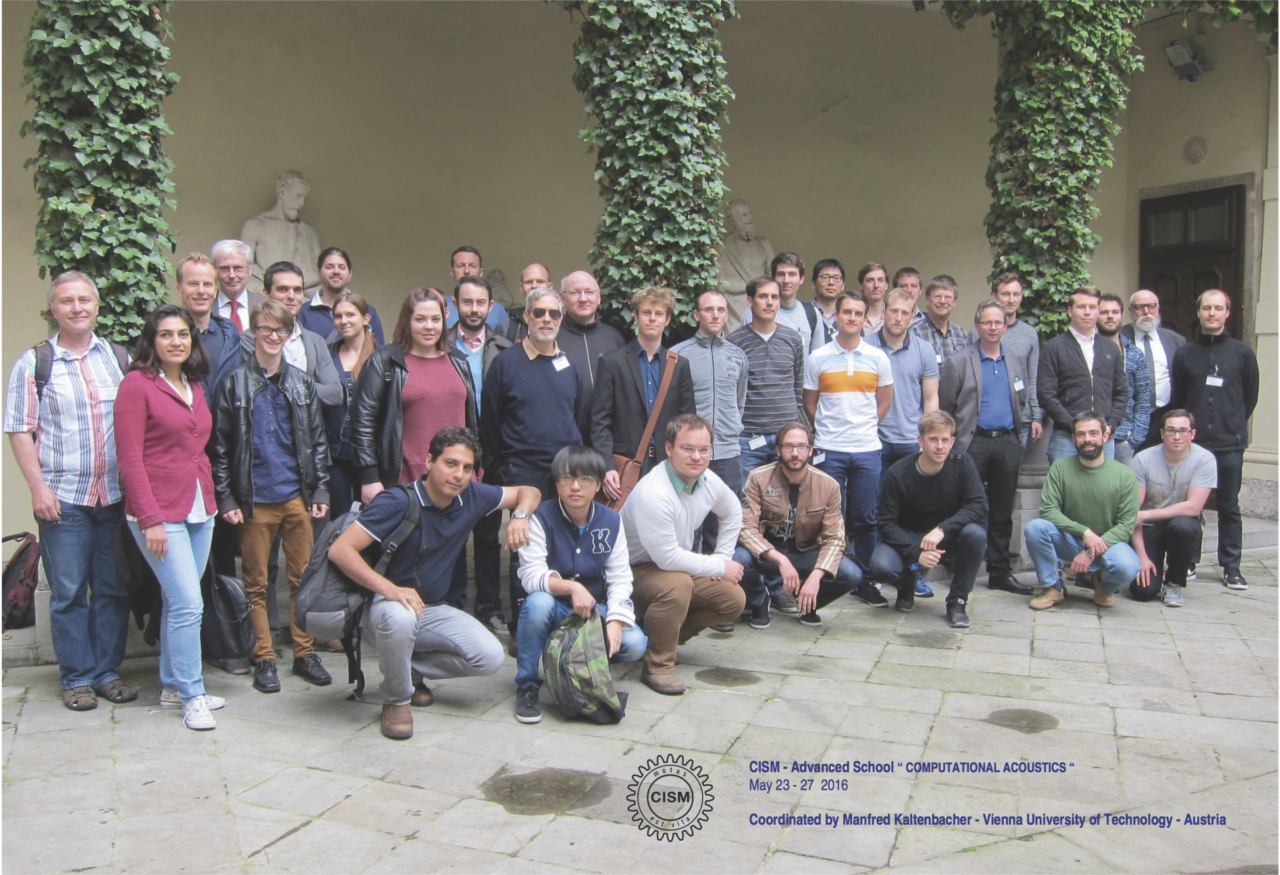
Official group picture of the CISM course 1602 (the photo is a courtesy of CISM).
Some persons claim that they are immune to advertising. We (that is Andreas Sturm, Jonas Köhler and David Hipp) can certainly not count us into that group of people: After multiple invitations over the central mailing list, we decided to participate in the CISM advanced school about ‘Computational Acoustics’ organized by Prof. Kaltenbacher (TU Wien) and sacrificed our Sunday and a holiday Thursday for the sake of scientific education.
CISM, International Centre for Mechanical Sciences, is a non-profit organization founded in 1968 and located in the beautiful and impressive Palazzo del Torso in Udine, Italy. The principal activity of CISM is the organization of courses, seminars, workshops and conferences to promote the exchange and application of advanced knowledge in mechanical science and in particular fields like robotics, biomechanics and environmental engineering.

CISM lecture hall in the Palazzo del Torso in Udine, Italy
A variety of topics relevant for the numerical simulation of acoustics was covered by the courses. Some of them tackled more applied questions, while others took a more theoretical perspective:
- The start was made by Prof. Manfred Kaltenbacher (Technische Universität Wien, Vienna, Austria) who gave us a very intuitive introduction to the physical models in acoustics. During his lectures he further talked about the coupling of acoustics to structural mechanics and flow dynamics. Prof. Kaltenbacher concluded the summer school by showing some very interesting examples from his research, namely the simulation of the noise by fans of air conditioning systems and of the generation of the human voice.
- The class of Spectral Element Methods was discussed by Prof. Gary Cohen (ENSTA ParisTech, Paris, France) who concentrated on the theoretical aspects of these methods. Besides that he also talked about the construction and properties of high order Finite Difference Methods and gave an overview of phenomena appearing in the usage of these methods when applied to the numerical simulation of partial differential equations.
- The modeling of problems on the whole space was one of the topics of the lectures given by Prof. Dan Givol (Technion – Israel Institute of Technology, Haifa, Israel) who presented several techniques to overcome the problem of an unbounded computational domain. During his lectures he mainly focused on perfectly matched layer techniques and (low and higher order) absorbing boundary conditions and highlighted differences as well as similarities of these methods. The second topic he covered were inverse problems and how to tackle them using the time reversal method. After giving a general introduction to inverse problems, he explained how to apply this method to specific classes of such problems and gave illustrative examples from his own research.
- The probably most purely mathematical series of lectures was given by Prof. Ulrich Langer and Dr. Martin Neumüller (both from Johannes Kepler Universität Linz, Linz, Austria) who both talked about solving sparse linear systems arising out of the discretization of partial differential equations. First, Prof. Langer gave an introduction to both advanced direct and iterative solvers and the use of preconditioners for iterative solvers. After this, a class of well-suited preconditioners for such problems, namely the multilevel and multigrid techniques, were presented in the talks by Dr. Neumüller.
- Another rather applied series of lectures was given by Prof. Steffen Marburg (Technische Universität München, Munich, Germany) who gave us an introduction into the Boundary Element Method and its efficient implementation. Here he also explained how coupled FE/BE methods can be used to simulate whole space problems where only relatively small parts of the domain have non-homogeneous material properties.
- The usage of higher order Spectral Element Methods, both continuous and discontinuous, for large scale simulations was presented by Prof. Claus Dieter Munz (Universität Stuttgart, Stuttgart, Germany). The main focus, however, lay on the discontinuous method and advantages over the continuous approach were discussed. He concluded by showing numerical results from a collaboration with a car manufacturer whose engineers observed varying noise for a particular side mirror design in experiments. The simulation of the air flow around the side mirror of a car was able to reproduce the effect and explain its varying nature.
Sometimes advertising makes us buy things we do not need or even want. This CISM summer school was quite the contrary: The topics of the lectures kept a good balance between the theoretical aspects of computational acoustics and the more goal-oriented perspective of engineers and physicists. As the group of participants had a heterogeneous background this mix of lecturers managed to keep the right level of complexity while giving (hopefully) most of us the ability to get into the topic.
And besides all the professional criteria, let us mention that Udine has a nice castle at the historic town center and a ton of splendid coffee shops and restaurants. So quite some possibilities to enjoy the Italian way of live. And if you are still not convinced, Venice is just a 1.5 hours train ride away…
All in all, we really enjoyed this CISM summer school and warmly recommend to use any chance to participate in a CISM course.